Long-Term Effectiveness of Tree Removal to Re-Establish Sagebrush Steppe Vegetation and Associated Spatial Patterns in Surface Conditions and Soil Hydrologic Properties
Abstract
1. Introduction
1.1. Woodland Encroachment into Sagebrush Steppe
1.2. Phases of Woodland Encroachment and Associated Effects
1.3. Tree Removal Practices to Conserve Sagebrush Steppe
1.4. Knowledge on the Ecohydrologic Impacts of Woodland Encroachment and Tree Removal
1.5. Knowledge Gaps and Research Need
2. Study Area
2.1. Site Descriptions
2.2. Tree Removal Treatments
3. Materials and Methods
3.1. Experimental Design
3.2. Hillslope-Scale Vegetation and Ground Cover
3.3. Tree Transects—Ground Surface Conditions and Soil Hydrologic Properties
3.4. Statistical Analyses
4. Result
4.1. Hillslope-Scale Vegetation and Ground Cover
4.2. Spatial Patterns in Ground Cover and Soil Hydrologic Properties along Tree Transects
4.3. Spatial Patterns in the Ground Cover and Soil Hydrologic Properties at the Patch Scale
5. Discussion
5.1. Treatment Effects on Hillslope-Scale Vegetation and Ground Cover
5.2. Treatment Effects on Patterns in Surface Conditions and Soil Hydrologic Properties
5.3. Implications for Cross-Scale Ecohydrologic Impacts of Tree Removal
6. Summary and Conclusions
Author Contributions
Funding
Acknowledgments
Conflicts of Interest
References
- Noss, R.F.; LaRoe, E.T.; Scott, A.C. Endangered Ecosystems of the United States: A Preliminary Assessment of Loss and Degradation; National Biological Service Report 28; US Department of the Interior, National Biological Service: Washington, DC, USA, 1995.
- Suring, L.H.; Rowland, M.M.; Wisdom, M.J. Identifying species of conservation concern. In Habitat Threats in the Sagebrush Ecosystem: Methods of Regional Assessment and Applications in the Great Basin; Wisdom, J.J., Rowland, M.M., Suring, L.H., Eds.; Alliance Communications Group: Lawrence, KS, USA, 2005; pp. 150–162. [Google Scholar]
- Davies, K.W.; Boyd, C.S.; Beck, J.L.; Bates, J.D.; Svejcar, T.J.; Gregg, M.A. Saving the sagebrush sea: An ecosystem conservation plan for big sagebrush plant communities. Biol. Conserv. 2011, 144, 2573–2584. [Google Scholar] [CrossRef]
- Miller, R.F.; Knick, S.T.; Pyke, D.A.; Meinke, C.W.; Hanser, S.E.; Wisdom, M.J.; Hild, A.L. Characteristics of sagebrush habitats and limitations to long-term conservation. In Greater Sage-Grouse, Ecology and Conservation of a Landscape Species and Its Habitats (Studies in Avian Biology, Book 38); Knick, S.T., Connelly, J.W., Eds.; University of California Press: Berkeley, CA, USA, 2011; pp. 145–184. [Google Scholar]
- Romme, W.H.; Allen, C.D.; Bailey, J.D.; Baker, W.L.; Bestelmeyer, B.T.; Brown, P.M.; Eisenhart, K.S.; Floyd, M.L.; Huffman, D.W.; Jacobs, B.F.; et al. Historical and modern disturbance regimes, stand structures, and landscape dynamics in pinon-juniper vegetation of the western United States. Rangel. Ecol. Manag. 2009, 62, 203–222. [Google Scholar] [CrossRef]
- Miller, R.F.; Chambers, J.C.; Evers, L.B.; Williams, C.J.; Snyder, K.A.; Roundy, B.A.; Pierson, F.B. The Ecology, History, Ecohydrology, and Management of Pinyon and Juniper Woodlands in the Great Basin and Northern Colorado Plateau of the Western United States; General Technical Report RMRS-GTR-403; US Department of Agriculture, Forest Service, Rocky Mountain Research Station: Fort Collins, CO, USA, 2019; p. 284.
- Miller, R.F.; Wigand, P.E. Holocene changes in semiarid pinyon-juniper woodlands. Response to climate, fire, and human activities in the US Great Basin. BioScience 1994, 44, 465–474. [Google Scholar] [CrossRef]
- Miller, R.F.; Tausch, R.J. The role of fire in juniper and pinyon woodlands: A descriptive analysis. In Proceedings of the Invasive Species Workshop: The Role of Fire in the Control and Spread of Invasive Species, Fire Conference 2000: The First National Congress on Fire Ecology, Prevention, and Management, Tallahassee, FL, USA, 27 November–1 December 2000; Galley, K.E.M., Wilson, T.P., Eds.; Tall Timbers Research Station: Tallahassee, FL, USA, 2001; pp. 15–30. [Google Scholar]
- Van Auken, O.W. Causes and consequences of woody plant encroachment into western North American grasslands. J. Environ. Manag. 2009, 90, 2931–2942. [Google Scholar] [CrossRef] [PubMed]
- Eldridge, D.J.; Bowker, M.A.; Maestre, F.T.; Roger, E.; Reynolds, J.F.; Whitford, W.G. Impacts of shrub encroachment on ecosystem structure and functioning: Towards a global synthesis. Ecol. Lett. 2011, 14, 709–722. [Google Scholar] [CrossRef]
- Archer, S.R.; Andersen, E.M.; Predick, K.I.; Schwinning, S.; Steidl, R.J.; Woods, S.R. Woody plant encroachment: Causes and consequences. In Rangeland Systems: Processes, Management, and Challenges; Briske, D.D., Ed.; Springer Nature: Cham, Switzerland, 2017; pp. 25–84. [Google Scholar]
- Miller, R.F.; Svejcar, T.J.; Rose, J.A. Impacts of western juniper on plant community composition and structure. J. Range Manag. 2000, 53, 574–585. [Google Scholar] [CrossRef]
- Miller, R.F.; Ratchford, J.; Roundy, B.A.; Tausch, R.J.; Hulet, A.; Chambers, J. Response of conifer-encroached shrublands in the Great Basin to prescribed fire and mechanical treatments. Rangel. Ecol. Manag. 2014, 67, 468–481. [Google Scholar] [CrossRef]
- Roundy, B.A.; Miller, R.F.; Tausch, R.J.; Young, K.; Hulet, A.; Rau, B.; Jessop, B.; Chambers, J.C.; Eggett, D. Understory cover responses to piñon-juniper treatments across tree dominance gradients in the Great Basin. Rangel. Ecol. Manag. 2014, 67, 482–494. [Google Scholar] [CrossRef]
- Knick, S.T.; Connelly, J.W. Greater Sage-Grouse, Ecology and Conservation of a Landscape Species and Its Habitats (Studies in Avian Biology, Book 38); University of California Press: Berkeley, CA, USA, 2011; p. 664. [Google Scholar]
- Pierson, F.B.; Bates, J.D.; Svejcar, T.J.; Hardegree, S.P. Runoff and erosion after cutting western juniper. Rangel. Ecol. Manag. 2007, 60, 285–292. [Google Scholar] [CrossRef]
- Petersen, S.L.; Stringham, T.K. Infiltration, runoff, and sediment yield in response to western juniper encroachment in southeast Oregon. Rangel. Ecol. Manag. 2008, 61, 74–81. [Google Scholar] [CrossRef]
- Pierson, F.B.; Williams, C.J.; Kormos, P.R.; Hardegree, S.P.; Clark, P.E.; Rau, B.M. Hydrologic vulnerability of sagebrush steppe following pinyon and juniper encroachment. Rangel. Ecol. Manag. 2010, 63, 614–629. [Google Scholar] [CrossRef]
- Williams, C.J.; Pierson, F.B.; Al-Hamdan, O.Z.; Kormos, P.R.; Hardegree, S.P.; Clark, P.E. Can wildfire serve as an ecohydrologic threshold-reversal mechanism on juniper-encroached shrublands? Ecohydrology 2014, 7, 453–477. [Google Scholar] [CrossRef]
- Williams, C.J.; Pierson, F.B.; Robichaud, P.R.; Al-Hamdan, O.Z.; Boll, J.; Strand, E.K. Structural and functional connectivity as a driver of hillslope erosion following disturbance. Int. J. Wildland Fire 2016, 25, 306–321. [Google Scholar] [CrossRef]
- Roundy, B.A.; Farmer, M.; Olson, J.; Petersen, S.; Nelson, D.R.; Davis, J.; Vernon, J. Runoff and sediment response to tree control and seeding on a high soil erosion potential site in Utah: Evidence for reversal of an abiotic threshold. Ecohydrology 2017, 10, e1775. [Google Scholar] [CrossRef]
- Bradley, B.A.; Mustard, J.F. Comparison of phenology trends by land cover class: A case study in the Great Basin, USA. Glob. Chang. Biol. 2008, 14, 334–346. [Google Scholar] [CrossRef]
- Balch, J.K.; Bradley, B.A.; D’Antonio, C.M.; Gómez-Dans, J. Introduced annual grass increases regional fire activity across the arid western USA (1980–2009). Glob. Chang. Biol. 2013, 19, 173–183. [Google Scholar] [CrossRef]
- Knapp, P.A. Cheatgrass (Bromus tectorum L) dominance in the Great Basin desert. History, persistence, and influences to human activities. Glob. Environ. Chang. 1996, 6, 37–52. [Google Scholar] [CrossRef]
- Brooks, M.L.; D’Antonio, C.M.; Richardson, D.M.; Grace, J.B.; Keeley, J.E.; DiTomaso, J.M.; Hobbs, R.J.; Pellant, M.; Pyke, D. Effects of invasive alien plants on fire regimes. BioScience 2004, 54, 677–688. [Google Scholar] [CrossRef]
- Link, S.O.; Keeler, C.W.; Hill, R.W.; Hagen, E. Bromus tectorum cover mapping and fire risk. Int. J. Wildland Fire 2006, 15, 113–119. [Google Scholar] [CrossRef]
- Bradley, B.A.; Curtis, C.A.; Fusco, E.J.; Abatzoglou, J.T.; Balch, J.K.; Dadashi, S.; Tuanmu, M.N. Cheatgrass (Bromus tectorum) distribution in the intermountain western United States and its relationship to fire frequency, seasonality, and ignitions. Biol. Invasions 2018, 20, 1493–1506. [Google Scholar] [CrossRef]
- Pierson, F.B.; Williams, C.J.; Hardegree, S.P.; Weltz, M.A.; Stone, J.J.; Clark, P.E. Fire, plant invasions, and erosion events on western rangelands. Rangel. Ecol. Manag. 2011, 64, 439–449. [Google Scholar] [CrossRef]
- Wilcox, B.P.; Turnbull, L.; Young, M.H.; Williams, C.J.; Ravi, S.; Seyfried, M.S.; Bowling, D.R.; Scott, R.L.; Germino, M.J.; Caldwell, T.G.; et al. Invasion of shrublands by exotic grasses: Ecohydrological consequences in cold versus warm deserts. Ecohydrology 2012, 5, 160–173. [Google Scholar] [CrossRef]
- Williams, C.J.; Pierson, F.B.; Robichaud, P.R.; Boll, J. Hydrologic and erosion responses to wildfire along the rangeland-xeric forest continuum in the western US: A review and model of hydrologic vulnerability. Int. J. Wildland Fire 2014, 23, 155–172. [Google Scholar] [CrossRef]
- Miller, R.F.; Chambers, J.C.; Pyke, D.A.; Pierson, F.B.; Williams, C.J. A Review of Fire Effects on Vegetation and Soils in the Great Basin Region: Response and Ecological Site Characteristics; General Technical Report RMRS-GTR-308; US Department of Agriculture, Forest Service, Rocky Mountain Research Station: Fort Collins, CO, USA, 2013; p. 126.
- Chambers, J.C.; Miller, R.F.; Board, D.I.; Pyke, D.A.; Roundy, B.A.; Grace, J.B.; Schupp, E.W.; Tausch, R.J. Resilience and resistance of sagebrush ecosystems: Implications for state and transition models and management treatments. Rangel. Ecol. Manag. 2014, 67, 440–454. [Google Scholar] [CrossRef]
- Chambers, J.C.; Bradley, B.A.; Brown, C.S.; D’Antonio, C.; Germino, M.J.; Grace, J.B.; Hardegree, S.P.; Miller, R.F.; Pyke, D.A. Resilience to stress and disturbance, and resistance to Bromus tectorum L. invasion in cold desert shrublands of western North America. Ecosystems 2014, 17, 360–375. [Google Scholar] [CrossRef]
- Williams, C.J.; Pierson, F.B.; Nouwakpo, S.K.; Al-Hamdan, O.Z.; Kormos, P.R.; Weltz, M.A. Effectiveness of prescribed fire to re-establish sagebrush steppe vegetation and ecohydrologic function on woodland-encroached sagebrush rangelands, Great Basin, USA: Part I: Vegetation, hydrology, and erosion responses. Catena 2020, 185, 103477. [Google Scholar] [CrossRef]
- Keane, R.E.; Agee, J.K.; Fuĺ, P.; Keeley, J.E.; Key, C.; Kitchen, S.G.; Miller, R.; Schulte, L.A. Ecological effects of large fires on US landscapes: Benefit or catastrophe? Int. J. Wildland Fire 2008, 17, 696–712. [Google Scholar] [CrossRef]
- Roundy, B.A.; Young, K.; Cline, N.; Hulet, A.; Miller, R.F.; Tausch, R.J.; Chambers, J.C.; Rau, B. Piñon-juniper reduction increases soil water availability of the resource growth pool. Rangel. Ecol. Manag. 2014, 67, 495–505. [Google Scholar] [CrossRef]
- Miller, R.F.; Bates, J.D.; Svejcar, T.J.; Pierson, F.B.; Eddleman, L.E. Biology, Ecology, and Management of Western Juniper, Oregon State University Agricultural Experiment Station Technical Bulletin 152; Oregon State University, Oregon State University Agricultural Experiment Station: Corvallis, OR, USA, 2005; p. 82. [Google Scholar]
- Miller, R.F.; Tausch, R.J.; McArthur, E.D.; Johnson, D.D.; Sanderson, S.C. Age Structure and Expansion of Piñon-Juniper Woodlands: A Regional Perspective in the Intermountain West; Research Paper Report RMRS-RP-69; US Department of Agriculture, Forest Service: Fort Collins, CO, USA, 2008; p. 15.
- Eckert, R.E.; Peterson, F.F.; Meurisse, M.S.; Stephens, J.L. Effects of soil-surface morphology on emergence and survival of seedlings in big sagebrush communities. J. Range Manag. 1986, 39, 414–420. [Google Scholar] [CrossRef]
- Pierson, F.B., Jr.; Van Vactor, S.S.; Blackburn, W.H.; Wood, J.C. Incorporating small scale spatial variability into predictions of hydrologic response on sagebrush rangelands. In Variability in Rangeland Water Erosion Processes, Soil Science Soceity of America Special Publication 38; Blackburn, W.H., Pierson, F.B., Schuman, G.E., Zartman, R., Eds.; Soil Science Society of America: Madison, WI, USA, 1994; pp. 23–34. [Google Scholar]
- Seyfried, M.S.; Wilcox, B.P. Scale and the nature of spatial variability: Field examples having implications for hydrologic modeling. Water Resour. Res. 1995, 31, 173–184. [Google Scholar] [CrossRef]
- Seyfried, M.S.; Wilcox, B.P. Soil water storage and rooting depth: Key factors controlling recharge on rangelands. Hydrol. Process. 2006, 20, 3261–3275. [Google Scholar] [CrossRef]
- Ryel, R.J.; Leffler, A.J.; Ivans, C.; Peek, M.S.; Caldwell, M.M. Functional differences in water-use patterns of contrasting life forms in Great Basin steppelands. Vadose Zone J. 2010, 9, 548–560. [Google Scholar] [CrossRef]
- Blackburn, W.H. Factors influencing infiltration and sediment production of semiarid rangelands in Nevada. Water Resour. Res. 1975, 11, 929–937. [Google Scholar] [CrossRef]
- Johnson, C.W.; Gordon, N.D. Runoff and erosion from rainfall simulator plots on sagebrush rangeland. Trans. Am. Soc. Agric. Eng. 1988, 31, 421–427. [Google Scholar] [CrossRef]
- Pierson, F.B.; Robichaud, P.R.; Moffet, C.A.; Spaeth, K.E.; Williams, C.J.; Hardegree, S.P.; Clark, P.E. Soil water repellency and infiltration in coarse-textured soils of burned and unburned sagebrush ecosystems. Catena 2008, 74, 98–108. [Google Scholar] [CrossRef]
- Pierson, F.B.; Robichaud, P.R.; Moffet, C.A.; Spaeth, K.E.; Hardegree, S.P.; Clark, P.E.; Williams, C.J. Fire effects on rangeland hydrology and erosion in a steep sagebrush-dominated landscape. Hydrol. Process. 2008, 22, 2916–2929. [Google Scholar] [CrossRef]
- Pierson, F.B.; Moffet, C.A.; Williams, C.J.; Hardegree, S.P.; Clark, P.E. Prescribed-fire effects on rill and interrill runoff and erosion in a mountainous sagebrush landscape. Earth Surf. Process. Landf. 2009, 34, 193–203. [Google Scholar] [CrossRef]
- Williams, C.J.; Pierson, F.B.; Kormos, P.R.; Al-Hamdan, O.Z.; Hardegree, S.P.; Clark, P.E. Ecohydrologic response and recovery of a semi-arid shrubland over a five year period following burning. Catena 2016, 144, 163–176. [Google Scholar] [CrossRef]
- Pierson, F.B.; Williams, C.J. Ecohydrologic Impacts of Rangeland Fire on Runoff and Erosion: A literature Synthesis; General Technical Report RMRS-GTR-351; US Department of Agriculture, Forest Service, Rocky Mountain Research Station: Fort Collins, CO, USA, 2016; p. 110.
- Johnson, C.W.; Blackburn, W.H. Factors contributing to sagebrush rangeland soil loss. Trans. Am. Soc. Agric. Eng. 1989, 32, 155–160. [Google Scholar] [CrossRef]
- Seyfried, M.S. Infiltration patterns from simulated rainfall on a semiarid rangeland soil. Soil Sci. Soc. Am. J. 1991, 55, 1726–1734. [Google Scholar] [CrossRef]
- Mollnau, C.; Newton, M.; Stringham, T. Soil water dynamics and water use in a western juniper (Juniperus occidentalis) woodland. J. Arid Environ. 2014, 102, 117–126. [Google Scholar] [CrossRef]
- Davenport, D.W.; Breshears, D.D.; Wilcox, B.P.; Allen, C.D. Viewpoint: Sustainability of pinon-juniper ecosystems—A unifying perspective of soil erosion thresholds. J. Range Manag. 1998, 51, 231–240. [Google Scholar] [CrossRef]
- Petersen, S.L.; Stringham, T.K.; Roundy, B.A. A process-based application of state-and-transition models: A case study of western juniper (Juniperus occidentalis) encroachment. Rangel. Ecol. Manag. 2009, 62, 186–192. [Google Scholar] [CrossRef]
- Bates, J.D.; Svejcar, T.J. Herbaceous succession after burning of cut western juniper trees. West. North. Am. Nat. 2009, 69, 9–25. [Google Scholar] [CrossRef]
- Bybee, J.; Roundy, B.A.; Young, K.R.; Hulet, A.; Roundy, D.B.; Crook, L.; Aanderud, Z.; Eggett, D.L.; Cline, N.L. Vegetation response to piñon and juniper tree shredding. Rangel. Ecol. Manag. 2016, 69, 224–234. [Google Scholar] [CrossRef]
- Bates, J.D.; Svejcar, T.; Miller, R.; Davies, K.W. Plant community dynamics 25 years after juniper control. Rangel. Ecol. Manag. 2017, 70, 356–362. [Google Scholar] [CrossRef]
- Bates, J.D.; Davies, K.W.; Hulet, A.; Miller, R.F.; Roundy, B. Sage grouse groceries: Forb response to piñon-juniper treatments. Rangel. Ecol. Manag. 2017, 70, 106–115. [Google Scholar] [CrossRef]
- Davies, K.W.; Rios, R.C.; Bates, J.D.; Johnson, D.D.; Kerby, J.; Boyd, C.S. To burn or not to burn: Comparing reintroducing fire with cutting an encroaching conifer for conservation of an imperiled shrub-steppe. Ecol. Evol. 2019, 9, 9137–9148. [Google Scholar] [CrossRef]
- Williams, C.J.; Pierson, F.B.; Kormos, P.R.; Al-Hamdan, O.Z.; Nouwakpo, S.K.; Weltz, M.A. Vegetation, hydrologic, and erosion responses of sagebrush steppe 9 yr following mechanical tree removal. Rangel. Ecol. Manag. 2019, 72, 47–68. [Google Scholar] [CrossRef]
- Bates, J.D.; Sharp, R.N.; Davies, K.W. Sagebrush steppe recovery after fire varies by development phase of Juniperus occidentalis woodland. Int. J. Wildland Fire 2014, 23, 117–130. [Google Scholar] [CrossRef]
- Davies, K.W.; Bates, J.D. Restoring big sagebrush after controlling encroaching western juniper with fire: Aspect and subspecies effects. Restor. Ecol. 2017, 25, 33–41. [Google Scholar] [CrossRef]
- Williams, R.E.; Roundy, B.A.; Hulet, A.; Miller, R.F.; Tausch, R.J.; Chambers, J.C.; Matthews, J.; Schooley, R.; Eggett, D. Pretreatment tree dominance and conifer removal treatments affect plant succession in sagebrush communities. Rangel. Ecol. Manag. 2017, 70, 759–773. [Google Scholar] [CrossRef]
- Williams, C.J.; Snyder, K.A.; Pierson, F.B. Spatial and temporal variability of the impacts of pinyon and juniper reduction on hydrologic and erosion processes across climatic gradients in the western US: A regional synthesis. Water 2018, 10, 1607. [Google Scholar] [CrossRef]
- Chambers, J.C.; Maestas, J.D.; Pyke, D.A.; Boyd, C.S.; Pellant, M.; Wuenschel, A. Using resilience and resistance concepts to manage persistent threats to sagebrush ecosystems and greater sage-grouse. Rangel. Ecol. Manag. 2017, 70, 149–164. [Google Scholar] [CrossRef]
- Urza, A.K.; Weisberg, P.J.; Chambers, J.C.; Dhaemers, J.M.; Board, D. Post-fire vegetation response at the woodland–shrubland interface is mediated by the pre-fire community. Ecosphere 2017, 8, e01851. [Google Scholar] [CrossRef]
- Urza, A.K.; Weisberg, P.J.; Chambers, J.C.; Board, D.; Flake, S.W. Seeding native species increases resistance to annual grass invasion following prescribed burning of semiarid woodlands. Biol. Invasions 2019, 21, 1993–2007. [Google Scholar] [CrossRef]
- Davies, K.W.; Bates, J.D.; Boyd, C.S. Postwildfire seeding to restore native vegetation and limit exotic annuals: An evaluation in juniper-dominated sagebrush steppe. Restor. Ecol. 2019, 27, 120–127. [Google Scholar] [CrossRef]
- Ernst-Brock, C.; Turner, L.; Tausch, R.J.; Leger, E.A. Long-term vegetation responses to pinyon-juniper woodland reduction treatments in Nevada, USA. J. Environ. Manag. 2019, 242, 315–326. [Google Scholar] [CrossRef]
- Boyd, C.S.; Kerby, J.D.; Svejcar, T.J.; Bates, J.D.; Johnson, D.D.; Davies, K.W. The sage-grouse habitat mortgage: Effective conifer management in space and time. Rangel. Ecol. Manag. 2017, 70, 141–148. [Google Scholar] [CrossRef]
- Harniss, R.O.; Murray, R.B. 30 Years of Vegetal Change Following Burning of sagebrush-grass range. J. Range Manag. 1973, 26, 322–325. [Google Scholar] [CrossRef]
- Ziegenhagen, L.L.; Miller, R.F. Postfire recovery of two shrubs in the interiors of large burns in the intermountain West USA. West. North. Am. Nat. 2009, 69, 195–205. [Google Scholar] [CrossRef]
- Bates, J.D.; Davies, K.W.; Sharp, R.N. Shrub-steppe early succession following juniper cutting and prescribed fire. Environ. Manag. 2011, 47, 468–481. [Google Scholar] [CrossRef] [PubMed]
- Bates, J.D.; Davies, K.W. Seasonal burning of juniper woodlands and spatial recovery of herbaceous vegetation. For. Ecol. Manag. 2016, 361, 117–130. [Google Scholar] [CrossRef]
- Bates, J.D.; Davies, K.W. Effects of conifer treatments on soil nutrient availability and plant composition in sagebrush steppe. For. Ecol. Manag. 2017, 400, 631–644. [Google Scholar] [CrossRef]
- Davies, K.W.; Bates, J.D. Longer-term evaluation of sagebrush restoration after juniper control and herbaceous vegetation trade-offs. Rangel. Ecol. Manag. 2019, 72, 260–265. [Google Scholar] [CrossRef]
- Pierson, F.B.; Williams, C.J.; Hardegree, S.P.; Clark, P.E.; Kormos, P.R.; Al-Hamdan, O.Z. Hydrologic and erosion responses of sagebrush steppe following juniper encroachment, wildfire, and tree cutting. Rangel. Ecol. Manag. 2013, 66, 274–289. [Google Scholar] [CrossRef]
- Nouwakpo, S.K.; Williams, C.J.; Al-Hamdan, O.Z.; Weltz, M.A.; Pierson, F.; Nearing, M. A review of concentrated flow erosion processes on rangelands: Fundamental understanding and knowledge gaps. Int. Soil Water Conserv. Res. 2016, 4, 75–86. [Google Scholar] [CrossRef]
- Pierson, F.B.; Williams, C.J.; Kormos, P.R.; Al-Hamdan, O.Z. Short-term effects of tree removal on infiltration, runoff, and erosion in woodland-encroached sagebrush steppe. Rangel. Ecol. Manag. 2014, 67, 522–538. [Google Scholar] [CrossRef]
- Williams, C.J.; Pierson, F.B.; Nouwakpo, S.K.; Kormos, P.R.; Al-Hamdan, O.Z.; Weltz, M.A. Long-term evidence for fire as an ecohydrologic threshold-reversal mechanism on woodland-encroached sagebrush shrublands. Ecohydrology 2019, 12, e2086. [Google Scholar] [CrossRef]
- Nouwakpo, S.K.; Williams, C.J.; Pierson, F.B.; Weltz, M.A.; Kormos, P.R.; Arslan, A.; Al-Hamdan, O.Z. Effectiveness of prescribed fire to re-establish sagebrush steppe vegetation and ecohydrologic function on woodlandencroached sagebrush rangelands, Great Basin, USA: Part II: Runoff and sediment transport at the patch scale. Catena 2020, 185, 104301. [Google Scholar] [CrossRef]
- Pierson, F.B.; Williams, C.J.; Kormos, P.R.; Al-Hamdan, O.Z.; Hardegree, S.P.; Clark, P.E. Short-term impacts of tree removal on runoff and erosion from pinyon- and juniper-dominated sagebrush hillslopes. Rangel. Ecol. Manag. 2015, 68, 408–422. [Google Scholar] [CrossRef]
- Stringham, T.K.; Snyder, K.A.; Snyder, D.K.; Lossing, S.S.; Carr, C.A.; Stringham, B.J. Rainfall interception by singleleaf piñon and utah juniper: Implications for stand-level effective precipitation. Rangel. Ecol. Manag. 2018, 71, 327–335. [Google Scholar] [CrossRef]
- Lebron, I.; Madsen, M.D.; Chandler, D.G.; Robinson, D.A.; Wendroth, O.; Belnap, J. Ecohydrological controls on soil moisture and hydraulic conductivity within a pinyon-juniper woodland. Water Resour. Res. 2007, 43, W08422. [Google Scholar] [CrossRef]
- Madsen, M.D.; Chandler, D.G.; Belnap, J. Spatial gradients in ecohydrologic properties within a pinyon-juniper ecosystem. Ecohydrology 2008, 1, 349–360. [Google Scholar] [CrossRef]
- Robinson, D.A.; Lebron, I.; Ryel, R.J.; Jones, S.B. Soil water repellency: A method of soil moisture sequestration in pinyon-juniper woodland. Soil Sci. Soc. Am. J. 2010, 74, 624–634. [Google Scholar] [CrossRef]
- Cline, N.L.; Roundy, B.A.; Pierson, F.B.; Kormos, P.; Williams, C.J. Hydrologic response to mechanical shredding in a juniper woodland. Rangel. Ecol. Manag. 2010, 63, 467–477. [Google Scholar] [CrossRef]
- McIver, J.; Brunson, M. Multidisciplinary, multisite evaluation of alternative sagebrush steppe restoration treatments: The SageSTEP project. Rangel. Ecol. Manag. 2014, 67, 435–439. [Google Scholar] [CrossRef][Green Version]
- McIver, J.; Brunson, M.; Bunting, S.; Chambers, J.; Doescher, P.; Grace, J.; Hulet, A.; Johnson, D.; Knick, S.; Miller, R.; et al. A synopsis of short-term response to alternative restoration treatments in Sagebrush-Steppe: The SageSTEP Project. Rangel. Ecol. Manag. 2014, 67, 584–598. [Google Scholar] [CrossRef]
- Prism Climate Group, Oregon State University. Available online: http://prism.oregonstate.edu/ (accessed on 23 January 2020).
- Natural Resources Conservation Service (NRCS). Soil Survey Geographic (SSURGO) Database for Western White Pine County Area, Nevada, Parts of White Pine and Eureka Counties; US Department of Agriculture, Natural Resources Conservation Service: Fort Worth, TX, USA, 2007.
- Natural Resources Conservation Service (NRCS). Soil Survey Geographic (SSURGO) Database for Tooele Area, Utah-Tooele County and Parts of Box Elder, Davis, and Juab Counties, Utah, White Pine and Elko Counties, Nevada; US Department of Agriculture, Natural Resources Conservation Service: Fort Worth, TX, USA, 2006; p. 611.
- Robichaud, P.R.; Lewis, S.A.; Ashmun, L.E. New Procedure for Sampling Infiltration to Assess Post-Fire Soil Water Repellency; Research Note RMRS-RN-33; US Department of Agriculture, Forest Service, Rocky Mountain Research Station: Fort Collins, CO, USA, 2008; p. 14.
- Breshears, D.D.; Nyhan, J.W.; Heil, C.E.; Wilcox, B.P. Effects of woody plants on microclimate in a semiarid woodland: Soil temperature and evaporation in canopy and intercanopy patches. Int. J. Plant. Sci. 1998, 159, 1010–1017. [Google Scholar] [CrossRef]
- DeBano, L.F. Water Repellent Soils: A State-of-the-Art; General Technical Report PSW-46; US Department of Agriculture, Forest Service, Pacific Southwest Forest and Range Experiment Station: Berkeley, CA, USA, 1981; p. 21.
- Bisdom, E.B.A.; Dekker, L.W.; Schoute, J.F.T. Water repellency of sieve fractions from sandy soils and relationships with organic material and soil structure. Geoderma 1993, 56, 105–118. [Google Scholar] [CrossRef]
- Madsen, M.D.; Zvirzdin, D.L.; Petersen, S.L.; Hopkins, B.G.; Roundy, B.A.; Chandler, D.G. Soil water repellency within a burned piñon-juniper woodland: Spatial distribution, severity, and ecohydrologic implications. Soil Sci. Soc. Am. J. 2011, 75, 1543–1553. [Google Scholar] [CrossRef]
- Zhang, R. Determination of soil sorptivity and hydraulic conductivity from the disk infiltrometer. Soil Sci. Soc. Am. J. 1997, 61, 1024–1030. [Google Scholar] [CrossRef]
- Van Genuchten, M.T. A closed-form equation for predicting the hydraulic conductivity of unsaturated soils. Soil Sci. Soc. Am. J. 1980, 44, 892–898. [Google Scholar] [CrossRef]
- Vandervaere, J.P.; Vauclin, M.; Elrick, D.E. Transient flow from tension infiltrometers: I. The two-parameter equation. Soil Sci. Soc. Am. J. 2000, 64, 1263–1272. [Google Scholar] [CrossRef]
- SAS Institute, Inc. SAS Software Version 9.4; SAS Institute, Inc.: Cary, NC, USA, 2013. [Google Scholar]
- Littell, R.C. SAS for Mixed Models, 2nd ed.; SAS Institute, Inc.: Cary, NC, USA, 2006; p. 829. [Google Scholar]
- Moffet, C.A.; Taylor, J.; Booth, D. Postfire shrub cover dynamics: A 70-year fire chronosequence in mountain big sagebrush communities. J. Arid Environ. 2015, 114, 116–123. [Google Scholar] [CrossRef]
- Tausch, R.J.; Tueller, P.T. Plant succession following chaining of pinyon-juniper woodlands in eastern Nevada. J. Range Manag. 1977, 30, 44–49. [Google Scholar] [CrossRef]
- Condon, L.; Weisberg, P.J.; Chambers, J.C. Abiotic and biotic influences on Bromus tectorum invasion and Artemisia tridentata recovery after fire. Int. J. Wildland Fire 2011, 20, 597–604. [Google Scholar] [CrossRef]
- Fernelius, K.J.; Madsen, M.D.; Hopkins, B.G.; Bansal, S.; Anderson, V.J.; Eggett, D.L.; Roundy, B.A. Post-fire interactions between soil water repellency, soil fertility and plant growth in soil collected from a burned piñon-juniper woodland. J. Arid Environ. 2017, 144, 98–109. [Google Scholar] [CrossRef]
- O’Connor, C.; Miller, R.; Bates, J.D. Vegetation response to western juniper slash treatments. Environ. Manag. 2013, 52, 553–566. [Google Scholar] [CrossRef] [PubMed]
- Davies, K.W.; Boyd, C.S.; Bates, J.D.; Gearhart, A. Legacy microsite effect on the survival of bitterbrush outplantings after prescribed fire: Capitalizing on spatial variability to improve restoration. Restor. Ecol. 2017, 25, 723–730. [Google Scholar] [CrossRef]
- Reisner, M.D.; Grace, J.B.; Pyke, D.A.; Doescher, P.S. Conditions favouring Bromus tectorum dominance of endangered sagebrush steppe ecosystems. J. Appl. Ecol. 2013, 50, 1039–1049. [Google Scholar] [CrossRef]
- Rau, B.M.; Chambers, J.C.; Pyke, D.A.; Roundy, B.A.; Schupp, E.W.; Doescher, P.; Caldwell, T.G. Soil resources influence vegetation and response to fire and fire-surrogate treatments in sagebrush-steppe ecosystems. Rangel. Ecol. Manag. 2014, 67, 506–521. [Google Scholar] [CrossRef]
- Chambers, J.C.; Roundy, B.A.; Blank, R.R.; Meyer, S.E.; Whittaker, A. What makes Great Basin sagebrush ecosystems invasible by Bromus tectorum? Ecol. Monogr. 2007, 77, 117–145. [Google Scholar] [CrossRef]
- Davies, K.W.; Johnson, D.D. Established perennial vegetation provides high resistance to reinvasion by exotic annual grasses. Rangel. Ecol. Manag. 2017, 70, 748–754. [Google Scholar] [CrossRef]
- Doerr, S.H.; Shakesby, R.A.; MacDonald, L.H. Soil water repellency: A key factor in post-fire erosion. In Fire Effects on Soils and Restoration Strategies; Cerdà, A., Robichaud, P.R., Eds.; Land Reconstruction and Management Series; Science Publishers: Enfield, NH, USA, 2009; Volume 5, pp. 197–224. [Google Scholar]
- Doerr, S.H.; Shakesby, R.A.; Walsh, R.P.D. Soil water repellency: Its causes, characteristics and hydro-geomorphological significance. Earth Sci. Rev. 2000, 51, 33–65. [Google Scholar] [CrossRef]
- Shakesby, R.A.; Doerr, S.H.; Walsh, R.P.D. The erosional impact of soil hydrophobicity: Current problems and future research directions. J. Hydrol. 2000, 231–232, 178–191. [Google Scholar] [CrossRef]
- Dekker, L.W.; Doerr, S.H.; Oostindie, K.; Ziogas, A.K.; Ritsema, C.J. Water repellency and critical soil water content in a dune sand. Soil Sci. Soc. Am. J. 2001, 65, 1667–1674. [Google Scholar] [CrossRef]
- MacDonald, L.H.; Huffman, E.L. Post-fire soil water repellency: Persistence and soil moisture thresholds. Soil Sci. Soc. Am. J. 2004, 68, 1729–1734. [Google Scholar] [CrossRef]
- Woods, S.W.; Birkas, A.; Ahl, R. Spatial variability of soil hydrophobicity after wildfires in Montana and Colorado. Geomorphology 2007, 86, 465–479. [Google Scholar] [CrossRef]
- Robichaud, P.R.; Wagenbrenner, J.W.; Pierson, F.B.; Spaeth, K.E.; Ashmun, L.E.; Moffet, C.A. Infiltration and interrill erosion rates after a wildfire in western Montana, USA. Catena 2016, 142, 77–88. [Google Scholar] [CrossRef]
- DeBano, L.F.; Savage, S.M.; Hamilton, D.A. The transfer of heat and hydrophobic substances during burning. Soil Sci. Soc. Am. J. 1976, 40, 779–782. [Google Scholar] [CrossRef]
- Robichaud, P.R.; Hungerford, R.D. Water repellency by laboratory burning of four northern Rocky Mountain forest soils. J. Hydrol. 2000, 231–232, 207–219. [Google Scholar] [CrossRef][Green Version]
- Huffman, E.L.; MacDonald, L.H.; Stednick, J.D. Strength and persistence of fire-induced soil hydrophobicity under ponderosa and lodgepole pine, Colorado Front Range. Hydrol. Process. 2001, 15, 2877–2892. [Google Scholar] [CrossRef]
- Reid, K.D.; Wilcox, B.P.; Breshears, D.D.; MacDonald, L. Runoff and erosion in a pinon-juniper woodland: Influence of vegetation patches. Soil Sci. Soc. Am. J. 1999, 63, 1869–1879. [Google Scholar] [CrossRef]
- Wilcox, B.P.; Breshears, D.D.; Allen, C.D. Ecohydrology of a resource-conserving semiarid woodland: Effects of scale and disturbance. Ecol. Monogr. 2003, 73, 223–239. [Google Scholar] [CrossRef]
- Ludwig, J.A.; Wilcox, B.P.; Breshears, D.D.; Tongway, D.J.; Imeson, A.C. Vegetation patches and runoff-erosion as interacting ecohydrological processes in semiarid landscapes. Ecology 2005, 86, 288–297. [Google Scholar] [CrossRef]
- Puigdefábregas, J. The role of vegetation patterns in structuring runoff and sediment fluxes in drylands. Earth Surf. Process. Landf. 2005, 30, 133–147. [Google Scholar] [CrossRef]
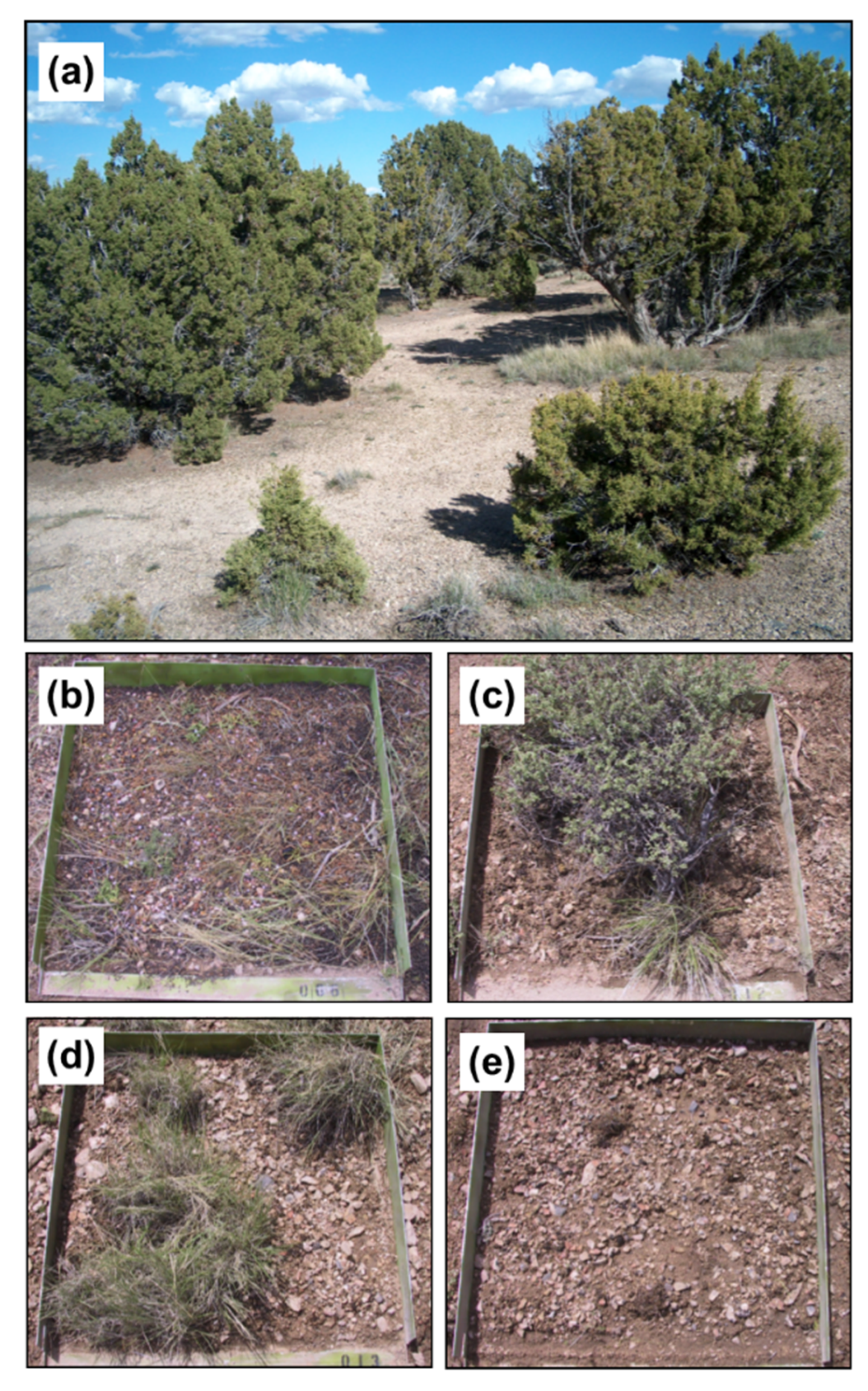
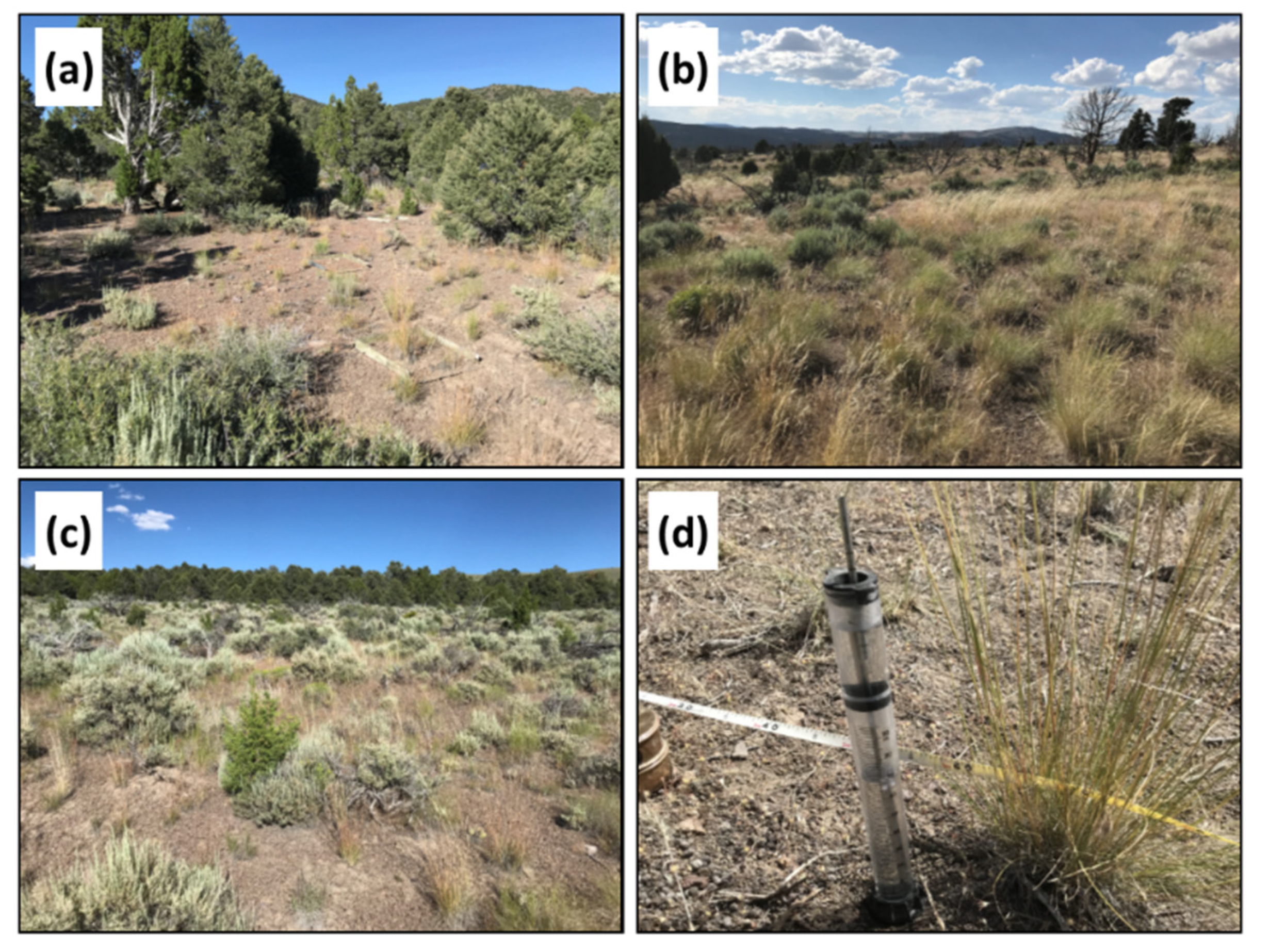
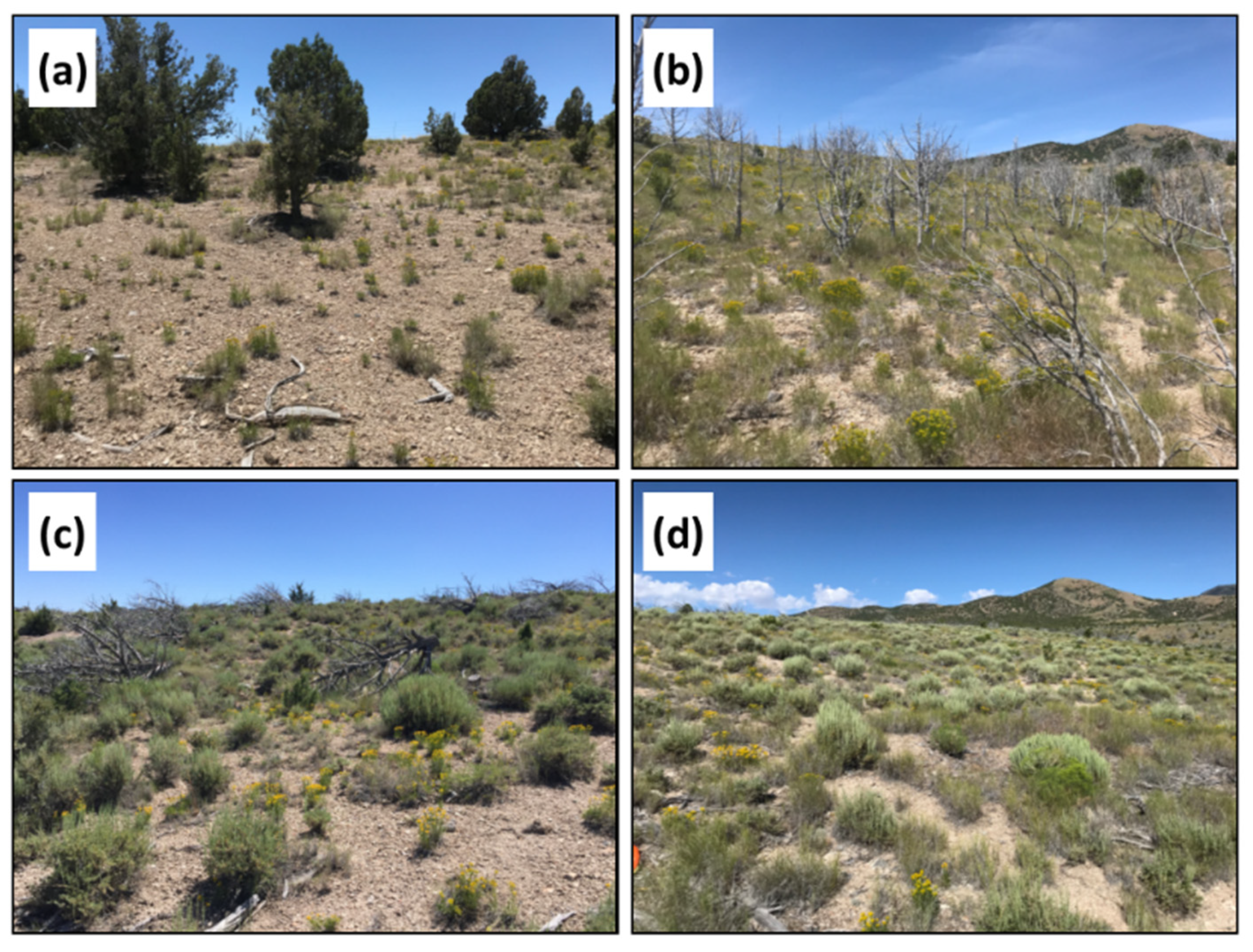
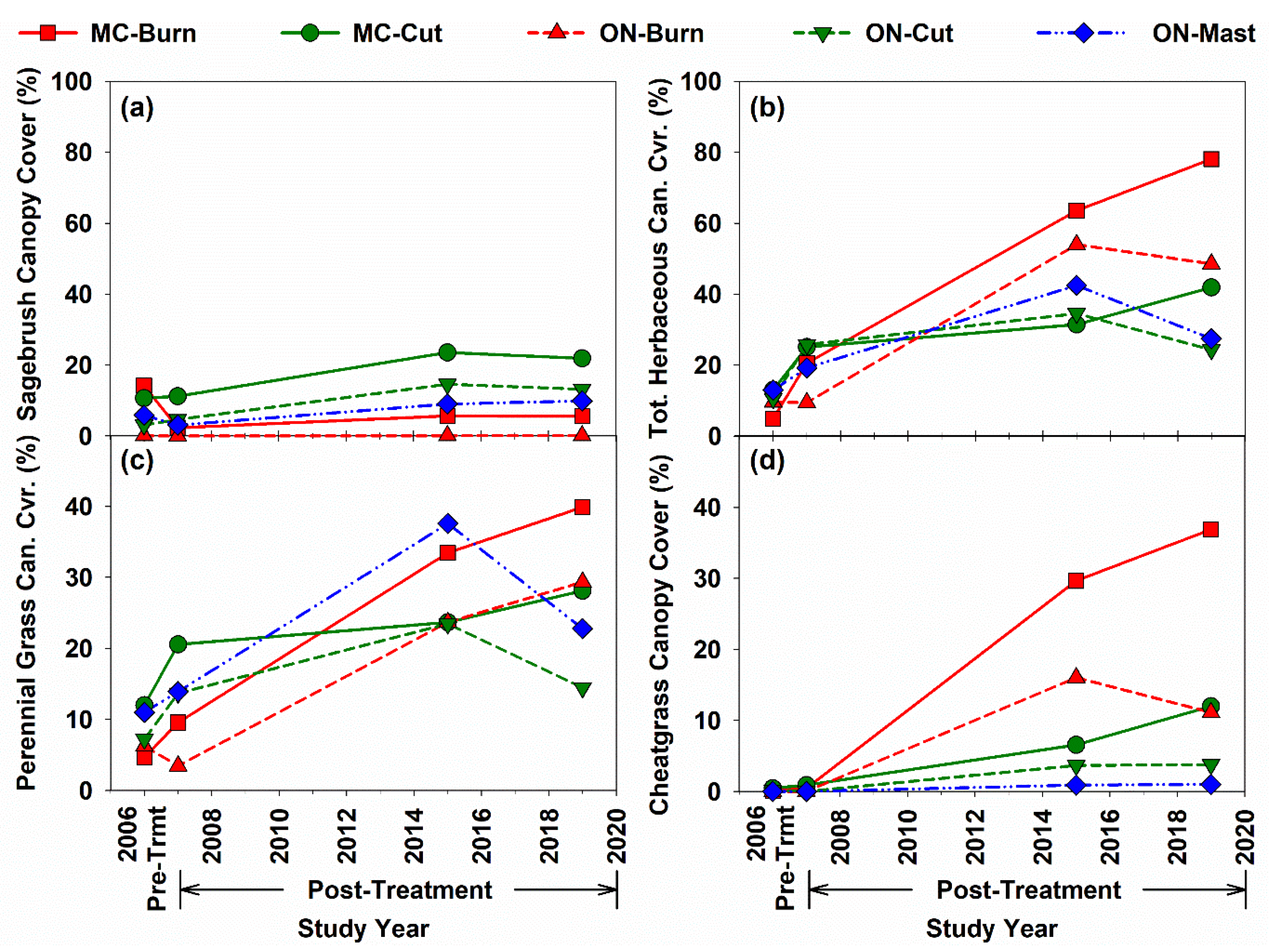

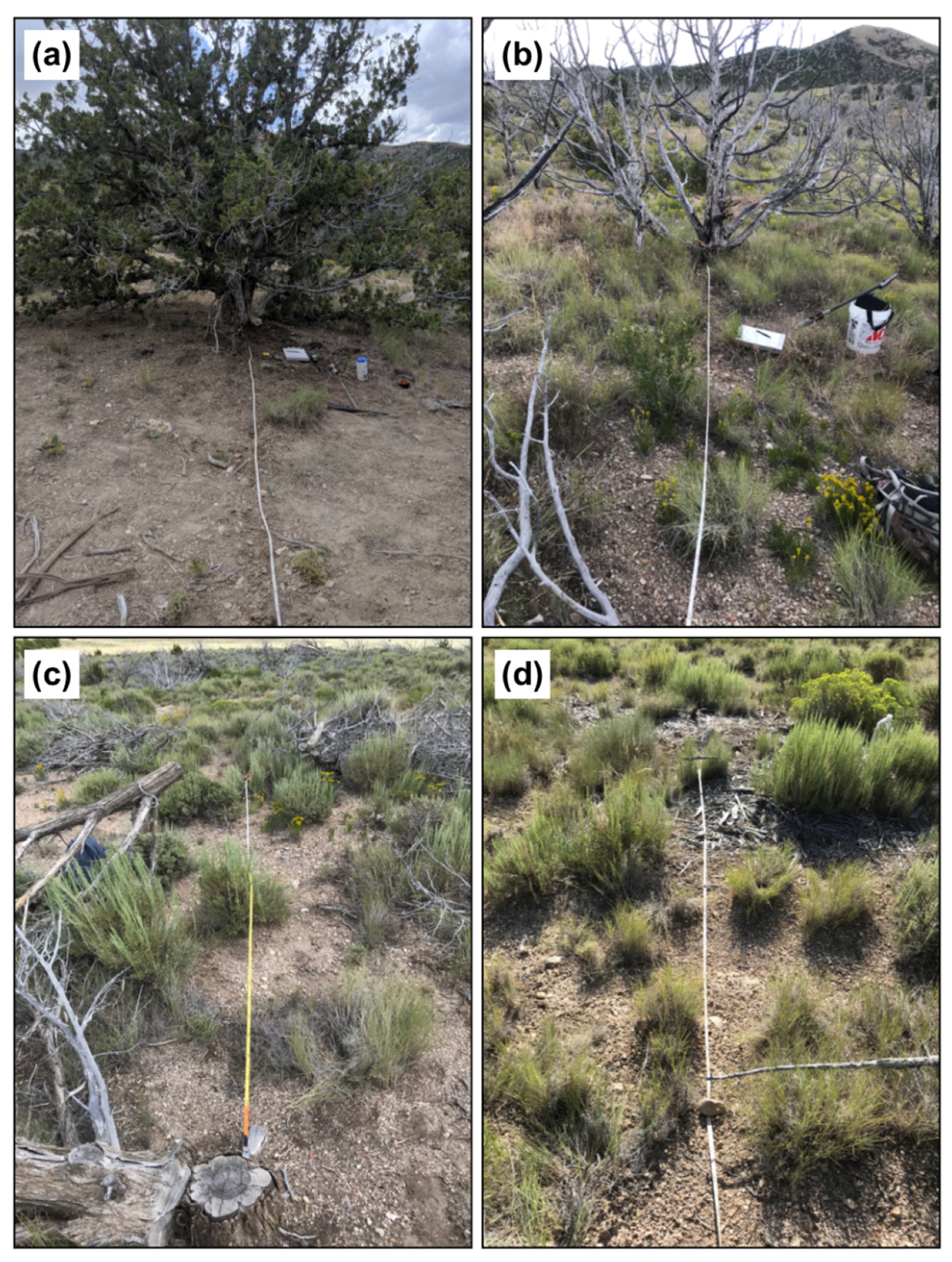
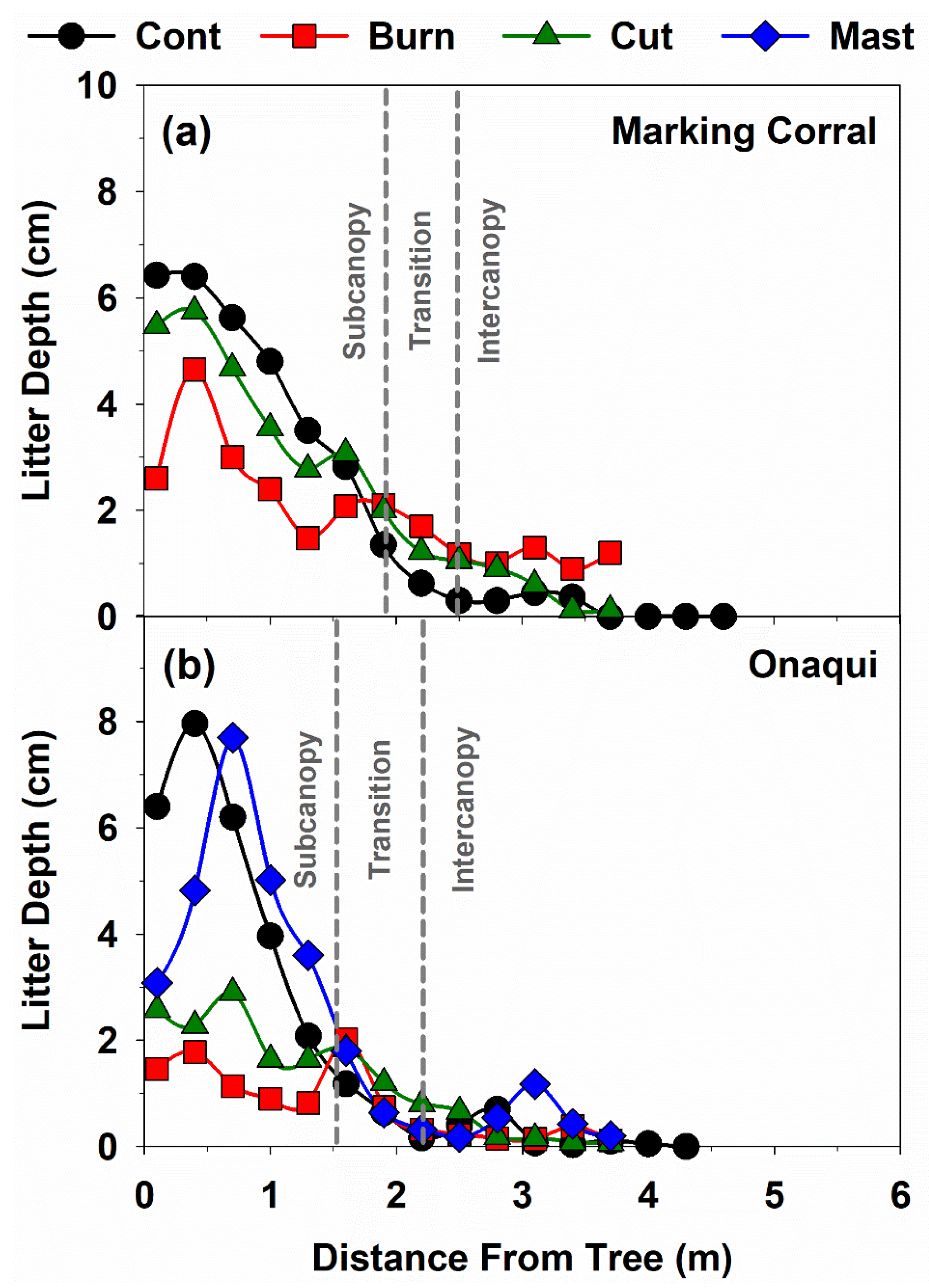
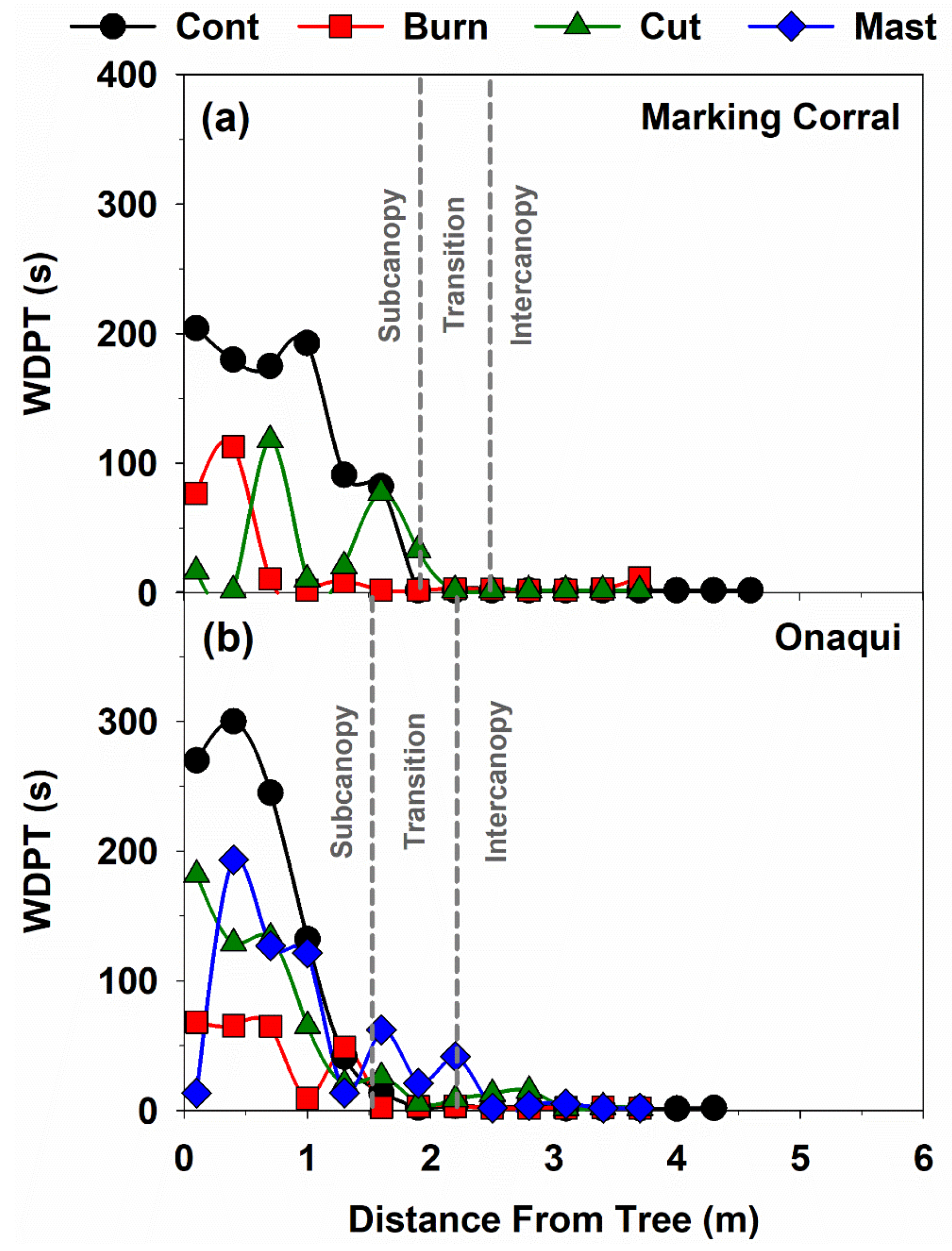
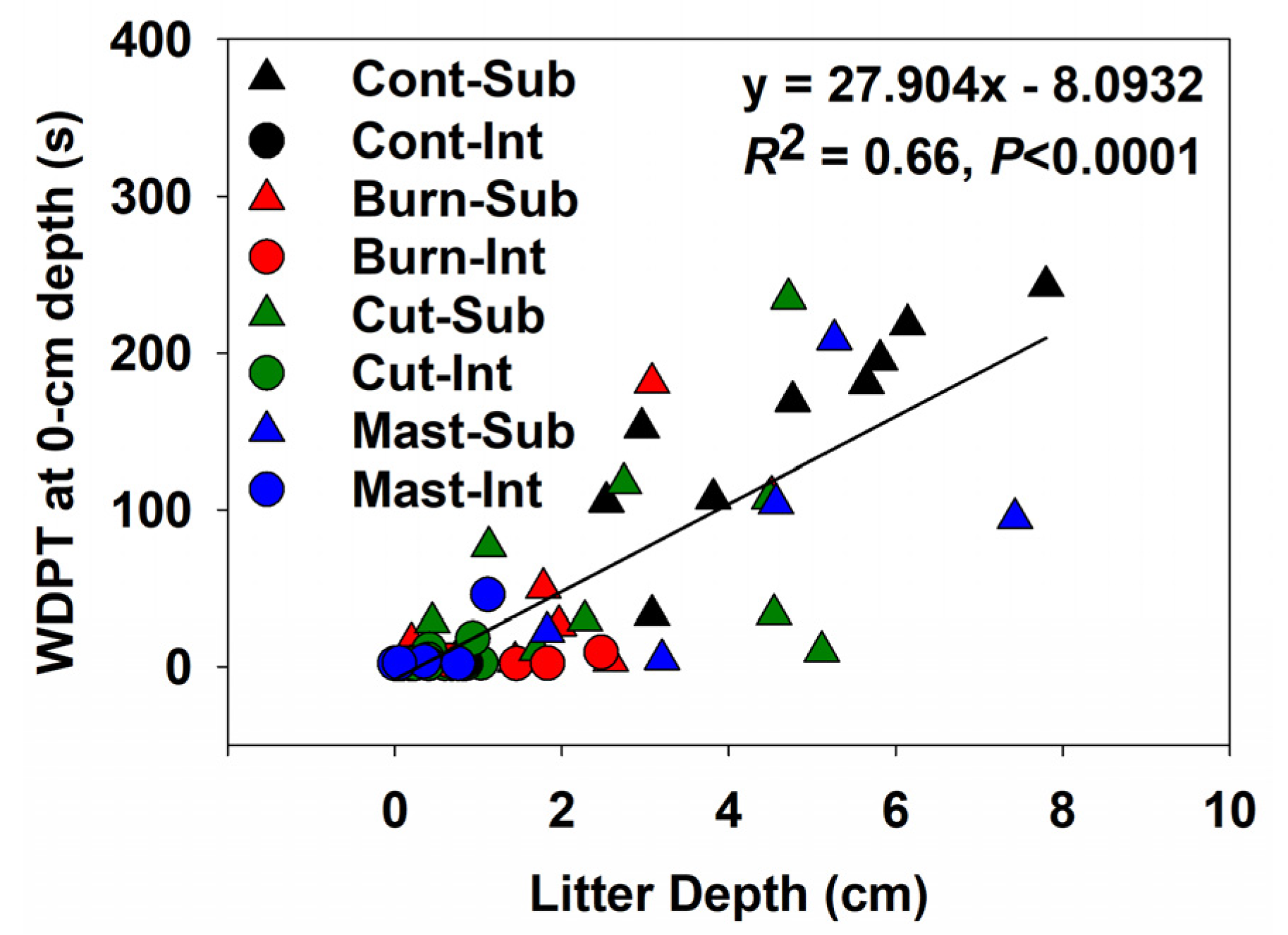
| Woodland Characteristics | Marking Corral, Nevada, USA | Onaqui, Utah, USA |
|---|---|---|
| Woodland community | single-leaf pinyon †/Utah juniper ‡ | Utah juniper ‡ |
| Encroachment phase § | Late Phase 2—Early Phase 3 | Late Phase 2—Early Phase 3 |
| Tree dominance index § | 0.51 | 0.66 |
| Elevation (m) and aspect | 2250—W to SW facing | 1720—N facing |
| Slope (%) | 10–15 | 10–15 |
| Mean ann. precipitation (mm) | 306 ¶ | 300 ¶ |
| Mean ann. air temperature (°C) | 6.5 ¶ | 8.9 ¶ |
| Parent rock | andesite and rhyolite ** | sandstone and limestone †† |
| Soil association | Segura-Upatad-Cropper ** | Borvant †† |
| Depth to bedrock (m) | 0.4–0.5 ** | 1.0–1.5 †† |
| Depth to restrictive layer (m) | 0.4–0.5 ** | 0.3–0.5 †† |
| Soil surface texture | sandy loam, 66% sand, 30% silt, 4% clay | sandy loam, 56% sand, 37% silt, 7% clay |
| Soil profile texture | gravelly clay to clay loam ** | gravelly loam †† |
| Tree canopy cover (%) ‡‡ | 15 †, 10 ‡ | 26 ‡ |
| Trees per ha ‡‡ | 329 †, 150 ‡ | 476 ‡ |
| Mean tree height (m) ‡‡ | 2.3 †, 2.4 ‡ | 2.4 ‡ |
| Juvenile trees per ha §§ | 296 †, 139 ‡ | 154 ‡ |
| Live shrubs per ha | 12,065 | 4914 |
| Dead shrubs per ha | 2065 | 957 |
| Intercanopy shrub canopy cover (%) | 21 | 5 |
| Intercanopy herbaceous canopy cover (%) ¶¶ | 13 | 11 |
| Intercanopy bare soil and rock (%) | 64 | 79 |
| Common understory plants | Artemisia tridentata Nutt. ssp. wyomingensis Beetle & Young; Artemisia nova A. Nelson; Artemisia tridentata Nutt. ssp. vaseyana (Rydb.) Bettle; Purshia spp.; Poa secunda J. Presl; Pseudoroegneria spicata (Pursh) A. Löve; and various forbs | |
| Marking Corral | Pre-Burn 2006 * | Burn 2007 † | Burn 2015 ‡ | Burn 2019 | Pre-Cut 2006 § | Cut 2007 † | Cut 2015 ¶ | Cut 2019 |
|---|---|---|---|---|---|---|---|---|
| Canopy Cover | ||||||||
| Total (%) | 26.8 a | 40.0 a | 76.9 bc | 93.2 c | 32.4 a | 67.9 b | 73.1 b | 82.8 bc |
| Shrub (%) | 17.7 b | 2.9 a | 8.7 ab | 11.0 ab | 14.6 b | 14.3 b | 28.7 c | 29.0 c |
| Grass (%) | 4.8 a | 10.0 ab | 63.1 e | 76.8 e | 12.4 ab | 21.4 bc | 30.2 cd | 40.1 d |
| Forb (%) | 0.1 a | 10.6 c | 0.9 ab | 1.3 ab | 1.0 ab | 3.7 b | 1.4 ab | 1.8 ab |
| Ground Cover | ||||||||
| Total (%) ** | 47.8 b | 31.5 a | 47.5 b | 62.2 cd | 51.5 bc | 48.2 b | 56.2 bcd | 63.9 d |
| Basal plant (%) | 0.3 a | 0.1 a | 7.1 b | 6.6 b | 0.3 a | 0.3 a | 8.2 b | 8.1 b |
| Litter & woody dead (%) | 47.4 bc | 31.4 a | 40.3 ab | 55.7 c | 51.1 bc | 47.6 bc | 47.9 bc | 55.8 bc |
| Rock (%) †† | 25.4 d | 16.5 cd | 12.8 bc | 8.2 b | 22.0 d | 11.3 bc | 1.3 a | 6.1 ab |
| Bare ground (%) ‡‡ | 52.2 c | 68.5 d | 52.5 c | 37.8 ab | 48.4 bc | 51.8 c | 43.8 abc | 36.1 a |
| Onaqui | Pre-Burn 2006 * | Burn 2007 † | Burn 2015 ‡ | Burn 2019 | Pre-Cut 2006 § | Cut 2007 † | Cut 2015 ¶ | Cut 2019 | Pre-Mast 2006 ** | Mast 2007 † | Mast 2015 ¶ | Mast 2019 |
|---|---|---|---|---|---|---|---|---|---|---|---|---|
| Canopy Cover | ||||||||||||
| Total (%) | 19.8 a | 17.6 a | 65.4 d | 63.8 d | 21.2 a | 55.2 cd | 59.9 d | 57.2 d | 30.8 ab | 29.1 ab | 53.9 cd | 39.8 bc |
| Shrub (%) | 0.9 ab | 0.3 a | 10.7 de | 4.8 cd | 3.4 bc | 5.0 cd | 16.9 e | 16.6 e | 6.1 cd | 3.1 bc | 9.9 de | 10.8 de |
| Grass (%) | 6.2 ab | 3.4 a | 39.7 de | 40.4 e | 7.3 ab | 13.7 bc | 27.1 cde | 18.2 bc | 11.0 ab | 13.9 bc | 38.5 de | 23.8 cd |
| Forb (%) | 3.3 ab | 6.0 abc | 14.3 d | 8.1 bcd | 3.2 ab | 12.1 cd | 7.4 bcd | 6.1 abc | 2.0 a | 5.3 ab | 4.0 ab | 3.7 ab |
| Ground Cover | ||||||||||||
| Total (%) †† | 39.9 ab | 32.5 a | 48.8 bc | 40.7 ab | 32.6 a | 48.6 bc | 47.3 bc | 40.3 ab | 42.5 b | 64.9 d | 55.6 cd | 43.0 b |
| Basal plant (%) | 0.9 a | 0.4 a | 13.3 cd | 4.9 b | 0.6 a | 0.2 a | 9.5 c | 4.3 b | 0.7 a | 0.1 a | 16.1 d | 3.9 b |
| Litter & woody dead (%) | 34.4 abc | 29.7 ab | 34.7 abc | 33.7 abc | 27.3 a | 43.6 c | 37.2 abc | 35.6 abc | 38.6 bc | 63.1 d | 37.0 abc | 39.1 bc |
| Rock (%) ‡‡ | 29.0 cd | 31.6 d | 21.6 bc | 29.2 cd | 29.8 cd | 22.3 bcd | 17.0 ab | 23.8 bcd | 20.1 bc | 11.2 a | 14.4 ab | 20.1 bc |
| Bare ground (%) §§ | 60.1 cd | 67.5 d | 51.2 bc | 59.3 cd | 67.5 d | 51.4 bc | 52.7 bc | 59.7 cd | 57.5 c | 35.1 a | 44.4 ab | 57.0 c |
| Transect Variable | Marking Corral | Onaqui | ||||||
|---|---|---|---|---|---|---|---|---|
| Control | Burn | Cut | Control | Burn | Cut | Mastication | ||
| Microsite occurrence (%) | ||||||||
| Tree | 49.6 a | 46.2 a | 53.8 a | 48.8 b | 30.8 a | 41.4 ab | 38.4 ab | |
| Shrub | 10.4 a | 0.0 a | 13.5 a | 4.0 a | 1.5 a | 6.3 a | 10.3 a | |
| Vegetated interspace | 16.7 a | 53.8 b | 17.3 a | 11.5 a | 52.3 b | 30.0 ab | 26.8 ab | |
| Bare interspace | 23.3 b | 0.0 a | 15.4 b | 35.7 b | 15.4 a | 22.3 ab | 24.5 ab | |
| Ground cover (%) | ||||||||
| Total ground cover * | 73.6 a | 92.3 a | 75.0 a | 62.6 a | 56.4 a | 58.7 a | 64.9 a | |
| Plant basal cover | 0.0 a | 1.9 ab | 13.5 b | 2.0 a | 9.2 a | 0.0 a | 3.3 a | |
| Litter & woody dead | 73.6 ab | 90.4 b | 61.5 a | 58.4 a | 40.6 a | 58.7 a | 60.1 a | |
| Rock † | 10.8 a | 1.9 a | 1.9 a | 32.4 a | 34.4 a | 25.4 a | 18.7 a | |
| Bare ground ‡ | 26.4 a | 7.7 a | 25.0 a | 37.4 a | 43.6 a | 41.3 a | 35.1 a | |
| Litter depth (cm) | 2.5 a | 2.5 a | 2.0 a | 2.4 a | 2.6 b | 0.8 a | 1.3 ab | |
| Total soil organic carbon, 0–5 cm depth (%) | 1.25 a | 1.25 a | 1.56 a | 1.62 a | 4.65 a | 6.02 a | 5.41 a | |
| Soil hydrologic properties | ||||||||
| WDPT 0-cm depth (s) § | 71 b | 18 a | 22 ab | 88 b | 22 a | 49 ab | 48 ab | |
| Wettable soil (%) ¶ | 62.8 a | 76.9 a | 73.1 a | 51.3 a | 73.8 a | 63.1 a | 64.2 a | |
| Slightly repellent (%) ¶ | 7.8 a | 17.3 a | 19.2 a | 15.3 a | 20.0 a | 15.9 a | 18.4 a | |
| Strongly repellent (%) ¶ | 29.4 b | 5.8 a | 7.7 a | 33.4 b | 6.2 a | 21.0 ab | 17.4 ab | |
| Hydraulic conductivity, K(h) (mm·h−1) ** | 39 a | 74 a | 60 a | 26 a | 36 a | 33 a | 40 a | |
| Relative infiltration (mL·min−1) **, †† | 11 a | 15 a | 10 a | 12 a | 11 a | 15 a | 14 a | |
| Number of transects | 4 | 4 | 4 | 4 | 5 | 5 | 5 | |
| Marking Corral | Control | Burn | Cut | ||||
|---|---|---|---|---|---|---|---|
| Intercanopy | Subcanopy | Intercanopy | Subcanopy | Intercanopy | Subcanopy | ||
| Microsite occurrence (%) | |||||||
| Tree | 0.0 a | 100.0 b | 0.0 a | 100.0 b | 4.2 a | 100.0 b | |
| Shrub | 21.1 b | 0.0 a | 0.0 a | 0.0 a | 29.2 b | 0.0 a | |
| Vegetated interspace | 34.9 b | 0.0 a | 100.0 c | 0.0 a | 36.3 b | 0.0 a | |
| Bare interspace | 44.0 b | 0.0 a | 0.0 a | 0.0 a | 30.3 b | 0.0 a | |
| Ground cover (%) | |||||||
| Total ground cover * | 47.6 a | 100.0 b | 93.8 b | 90.0 b | 48.8 a | 100.0 b | |
| Plant basal cover | 0.0 a | 0.0 a | 3.1 a | 0.0 a | 28.0 b | 0.0 a | |
| Litter & woody dead | 47.6 a | 100.0 b | 90.6 b | 90.0 b | 20.8 a | 100.0 b | |
| Rock † | 22.1 a | 0.0 a | 3.1 a | 0.0 a | 28.0 a | 0.0 a | |
| Bare ground ‡ | 52.4 b | 0.0 a | 6.2 a | 10.0 a | 51.2 b | 0.0 a | |
| Litter depth (cm) | 0.4 a | 4.7 d | 1.4 bc | 2.6 cd | 0.7 ab | 4.0 d | |
| Total soil organic carbon,0–5 cm depth (%) | 1.11 a | 1.54 a | 1.47 a | 1.76 a | 1.60 a | 1.67 a | |
| Soil hydrologic properties | |||||||
| WDPT 0-cm depth (s) § | <5 a | 138 c | <5 a | 35 b | <5 a | 40 b | |
| Wettable soil (%) ¶ | 100.0 c | 25.5 a | 85.7 bc | 67.0 bc | 100.0 c | 49.4 ab | |
| Slightly repellent (%) ¶ | 0.0 a | 17.1 ab | 14.3 ab | 20.5 ab | 0.0 a | 36.3 b | |
| Strongly repellent (%) ¶ | 0.0 a | 57.4 b | 0.0 a | 12.5 a | 0.0 a | 14.3 a | |
| Hydraulic conductivity, K(h) (mm·h−1) ** | 34 a | 48 ab | 71 b | 79 b | 49 ab | 81 b | |
| Relative infiltration (mL·min−1) **, †† | 13 bc | 6 ab | 18 c | 10 ab | 13 bc | 4 a | |
| Onaqui | Control | Burn | Cut | Mastication | |||||
|---|---|---|---|---|---|---|---|---|---|
| Intercanopy | Subcanopy | Intercanopy | Subcanopy | Intercanopy | Subcanopy | Intercanopy | Subcanopy | ||
| Microsite occurrence (%) | |||||||||
| Tree | 0.0 a | 96.7 c | 0.0 a | 77.3 b | 3.3 a | 100.0 c | 0.0 a | 81.7 bc | |
| Shrub | 6.7 ab | 0.0 a | 2.5 a | 0.0 a | 9.2 ab | 0.0 a | 19.2 b | 0.0 a | |
| Vegetated interspace | 16.9 ab | 3.3 a | 77.5 c | 15.3 ab | 53.1 bc | 0.0 a | 43.1 bc | 8.3 a | |
| Bare interspace | 76.4 c | 0.0 a | 20.0 ab | 7.3 a | 34.4 b | 0.0 a | 37.7 b | 10.0 a | |
| Ground cover (%) | |||||||||
| Total ground cover * | 24.2 a | 100.0 c | 51.1 ab | 65.3 bc | 41.1 ab | 85.0 c | 41.4 ab | 95.0 c | |
| Plant basal cover | 5.0 a | 0.0 a | 13.2 a | 3.3 a | 0.0 a | 0.0 a | 4.0 a | 3.3 a | |
| Litter & woody dead | 19.2 a | 96.7 c | 37.9 ab | 46.0 b | 41.1 ab | 85.0 c | 34.5 ab | 91.7 c | |
| Rock † | 65.4 c | 0.0 a | 43.9 bc | 20.0 ab | 40.8 bc | 0.0 a | 28.9 ab | 5.0 a | |
| Bare ground ‡ | 75.8 c | 0.0 a | 48.9 bc | 34.7 ab | 58.9 bc | 15.0 a | 58.6 bc | 5.0 a | |
| Litter depth (cm) | 0.3 a | 4.7 c | 0.6 a | 1.2 ab | 0.5 a | 2.3 bc | 0.5 a | 4.5 c | |
| Total soil organic carbon, 0–5 cm depth (%) | 4.40 a | 5.16 a | 6.00 a | 6.07 a | 5.46 a | 5.33 a | 5.79 a | 6.44 a | |
| Soil hydrologic properties | |||||||||
| WDPT 0-cm depth (s) § | <5 a | 170 b | <5 a | 51 b | 7 a | 97 b | 11 a | 87 b | |
| Wettable soil (%) ¶ | 92.1 c | 15.7 a | 89.3 c | 48.7 b | 80.6 c | 36.4 ab | 85.9 c | 40.7 ab | |
| Slightly repellent (%) ¶ | 7.9 a | 20.2 ab | 10.7 a | 35.3 b | 16.9 ab | 20.0 ab | 8.4 a | 28.6 ab | |
| Strongly repellent (%) ¶ | 0.0 a | 64.1 c | 0.0 a | 16.0 ab | 2.5 a | 43.6 c | 5.7 a | 30.7 bc | |
| Hydraulic conductivity, K(h) (mm·h−1) ** | 17 a | 46 bc | 42 bc | 24 ab | 25 ab | 50 bc | 20 ab | 81 c | |
| Relative infiltration (mL·min−1) **,†† | 15 b | 6 a | 12 ab | 9 ab | 16 b | 11 ab | 16 b | 9 ab | |
© 2020 by the authors. Licensee MDPI, Basel, Switzerland. This article is an open access article distributed under the terms and conditions of the Creative Commons Attribution (CC BY) license (http://creativecommons.org/licenses/by/4.0/).
Share and Cite
Williams, C.J.; Johnson, J.C.; Pierson, F.B.; Burleson, C.S.; Polyakov, V.O.; Kormos, P.R.; Nouwakpo, S.K. Long-Term Effectiveness of Tree Removal to Re-Establish Sagebrush Steppe Vegetation and Associated Spatial Patterns in Surface Conditions and Soil Hydrologic Properties. Water 2020, 12, 2213. https://doi.org/10.3390/w12082213
Williams CJ, Johnson JC, Pierson FB, Burleson CS, Polyakov VO, Kormos PR, Nouwakpo SK. Long-Term Effectiveness of Tree Removal to Re-Establish Sagebrush Steppe Vegetation and Associated Spatial Patterns in Surface Conditions and Soil Hydrologic Properties. Water. 2020; 12(8):2213. https://doi.org/10.3390/w12082213
Chicago/Turabian StyleWilliams, C. Jason, Justin C. Johnson, Frederick B. Pierson, Cameron S. Burleson, Viktor O. Polyakov, Patrick R. Kormos, and S. Kossi Nouwakpo. 2020. "Long-Term Effectiveness of Tree Removal to Re-Establish Sagebrush Steppe Vegetation and Associated Spatial Patterns in Surface Conditions and Soil Hydrologic Properties" Water 12, no. 8: 2213. https://doi.org/10.3390/w12082213
APA StyleWilliams, C. J., Johnson, J. C., Pierson, F. B., Burleson, C. S., Polyakov, V. O., Kormos, P. R., & Nouwakpo, S. K. (2020). Long-Term Effectiveness of Tree Removal to Re-Establish Sagebrush Steppe Vegetation and Associated Spatial Patterns in Surface Conditions and Soil Hydrologic Properties. Water, 12(8), 2213. https://doi.org/10.3390/w12082213








